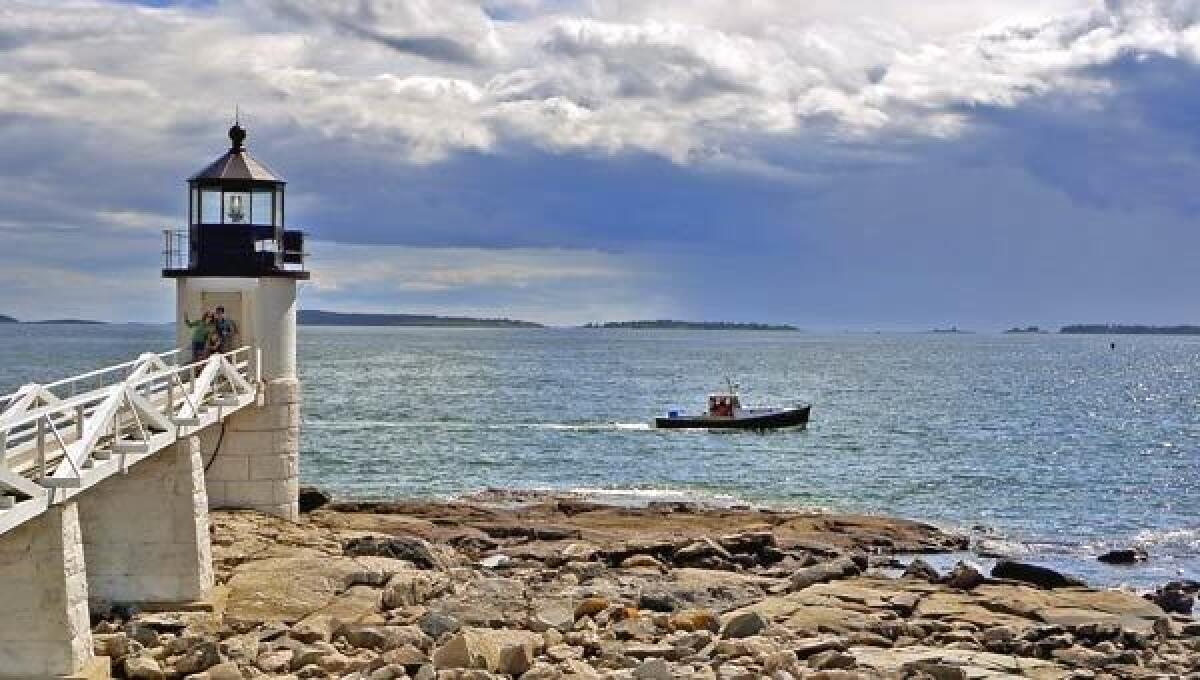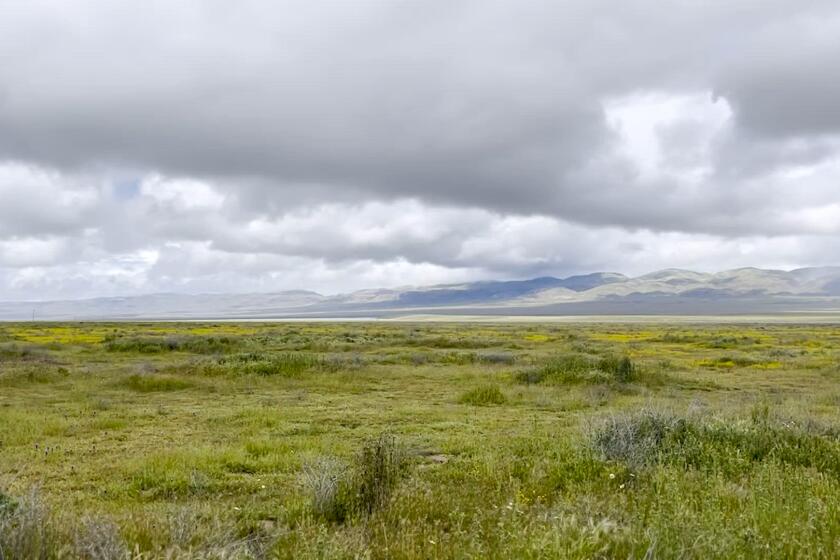Coastal Maine: Etched in the heart

The Olson House is hard to find, but once you arrive, there is no mistaking it. We made a few wrong turns at first, my brother and his wife, my wife, Margie, and I. The four of us had had taken this day trip to the village of Cushing just three years ago, and you’d think we’d know the way.
We got directions — and suggest you do the same — in Thomaston off Route 1 at the Prison Showroom, a small gift shop that sells crafts made by prisoners of Maine’s Department of Corrections.
Ten miles later, down narrow back roads cut through fields and woods, we pulled into the parking lot, and the Olsons’ three-story clapboard farmhouse loomed above us much as it did for Andrew Wyeth more than 60 years ago.
Not everyone will want to make the trip. The seaside towns that extend from Brunswick to Bar Harbor are far more inviting than this 20-minute detour off the main drag. Never mind the fact that Wyeth memorialized the setting with canvases that are part of the canon, including his most famous one, “Christina’s World.” The Olson House is an acquired taste.
THE BEST WAY TO THE MAINE COAST
From LAX, nonstop service to Boston is available on American, JetBlue, Virgin America and United; direct service (stop, no change of plane) is offered on Delta and Southwest; and connecting service (change of planes) is available on United, Southwest, AirTran, Delta, US Airways and American. Restricted round-trip fares begin at $378.
Set on a slight knoll partially adorned by orange day lilies, it keeps its distance, aloof, monumental, almost defiant. Winter pounds the weathered wood; summer bakes it. Its rooms are forlorn, nearly empty, the floor bearing the faint impressions of stenciled leaves, the walls some ghostly patterned paper.
But its indifference is its appeal. The Olson House has a timeless quality, as if it exists at some intersection of past and present, a place that seems both permanent and ephemeral.
For almost 30 years, Wyeth returned to this spot. He savored the character of the house and the company of his friends, Christina and Alvaro Olson. “I just couldn’t stay away from there,” he said. “I did other pictures … but I’d always seem to gravitate to the house.... It was Maine.”
Wyeth, of course, was lucky. He had a lifetime to discover Maine in the suspended moments that define the essence of this place — a breeze wafting through an open window, an oar lying on a stone wall, the far-off stare in a local’s eye — but we had only a week.
Fortunately, we had a slight advantage.
Roots here
My grandparents came to Maine in 1926, renting a home in a town called New Harbor. It was here that my father spent his summers, playing the prankster, tipping over outhouses, shooting squirrels and sailing model boats.
My family was no different from most New Englanders who each summer traded the inland heat and humidity for the fog and the cool of the coast. These vacationers of late 18th and early 19th century — rusticators, they called themselves, an openhearted exhortation to the virtues of a rustic lifestyle — transformed the local economy when exports of granite, ice, salt cod and lumber began to fail. They made Maine the “Vacationland State” it is today.
But vacationland has its price. There is a frantic side to the economy as merchants try to wrestle a year’s worth of living out of the summer months. They cater to out-of-towners, perhaps resenting them a little too, and play up an idea of Maine — lobster knickknacks, ol’ fisherman tchotchkes, balsam air fresheners — that seems almost a parody of the life that once defined this region.
When New Harbor grew too crowded for my grandparents in 1941, they bought a cottage overlooking Pig’s Cove on Southport Island for $2,000. Today that cottage is owned by my uncle, who is in his 80s and with the help of my aunt turns our visits into long-overdue reunions. We rent the cottage next to theirs (seven days, $1,300) and make ourselves at home.
With three bedrooms, one bath, our rental is a place of wonder, testimony to more than 50 years of its owner’s comings and goings: shelves crammed with books and board games, mismatched antiques, circle throw rugs, appliances that should be in the Smithsonian, driftwood mobiles hung from the ceiling that catch the breeze through the open door.
In the mornings, we awaken to the put-put-put-put of the fishing boats and gaze out the window at lobstermen moving from buoy to buoy. With a hook and a well-practiced swing, they winch the traps to the surface, pull out the legal bugs — or sing out, “No keepahs herah” — and move onto the next.
At night, we sit on the porch and listen to a foghorn in the distance and the surge of the tide running through the rock weed. Lights of boats cut through the darkness; shooting stars sear the sky.
Where Wyeth found Maine in the Olson House, we have discovered these quiet moments and in the companionship of family and friends, coffee in the morning, dinner at night. Our recent trip was that perfect, except for one inconvenience: The water heater was broken.
We made do (and were compensated). Cold water does have a certain aesthetic, and we could always shower next door when we wished. We also took the occasion to get to know Alfred Moses, de facto caretaker of the cottages along this road. His family has lived here on and off since 1870 when an Episcopal parish paid to build a home for his great-grandfather, the Rev. John T. Magrath.
At 67, Moses is a garrulous man, every anecdote a story, and we welcomed him when he knocked on the back porch one morning. He came to look at the plumbing, and we enjoyed the chance to talk. He recommended a day trip to Damariscove Island. He identified the robins that woke us at dawn. He guessed the temperature of the ocean at 58 degrees. He identified the birds.
We listened and asked, “Could you live anywhere else?”
He shook his head. The winters are hard, and worse than the cold is the darkness. The sun sets at 4 and doesn’t rise until after 8, but no, he said, pausing, this is home.
“There’s kind of feng shui here,” he said. “I can stand on my front porch and look east and see Monhegan Island and to the south — there’re the Cuckolds,” referring to the lighthouse at the southern tip of Southport. “It orients me, this view. I can’t imagine not being here.”
Driving the coast
After visiting the Olson House and Wyeth’s grave on a point of land overlooking the St. George River — an hour drive from Southport and the Boothbay Harbor region — we drove to Port Clyde, where we had fish and chips and lingered over our Lobster Ales as a rain squall passed.
When the sun broke through, we drove to Marshall Point Lighthouse, built in 1858 and made famous in 1994 when Tom Hanks ran along its footbridge in “Forrest Gump.” We took pictures and watched as the storm moved out to sea and a lone fishing boat worked against the tide.
We had hoped to continue to Rocklandto see the Wyeth collection at the local museum, and possibly even go into Camden for some blueberry pie, but it was late afternoon.
Driving the coast of Maine has its rewards — the roadside produce stands (strawberries in June, blueberries in August), the Colonial villages, the church steeples poking through the canopy of trees, Civil War monuments, the quick glimpses of daily life — but it can be frustrating. Route 1 is the primary way from Brunswick to Camden, and the two-lane roads that snake down to the sea can be choked with traffic made worse by road repairs.
The problem, of course, is the topography itself, the long peninsulas and tidal rivers of this drowned coastline, as geologists describe this edge of the continent, where glaciers over the last few millions of years scraped soil from the rocks and eroded the rocks themselves.
Some speculate that the coast of Maine used to resemble the gently sloping New Jersey seaside, but as the last glaciers melted some 15,000 years ago, they flooded the valleys and turned mountains into islands. Today the coast is so convoluted that from New Hampshire to Canada, 293 miles as the crow flies, there are nearly 5,500 miles of tidelands.
It’s an invitation for renting a boat — or for at least accepting the generosity of an uncle whose 19-foot outboard sits moored just a short row from shore.
On the water
The next day we skipped across the water at 22 knots, visiting harbors and wharves that would have taken us hours to reach by car. The weather was perfect, the breeze warm and from the southeast.
Our road map was the nautical chart of the Damariscotta, Sheepscot and Kennebec rivers. Few documents better capture the romance and mystery of Maine. It became our guide to the Cuckolds and the Hypocrites, a neighboring ridge of semi-submerged rocks; to the ledges, guts and reaches of Boothbay Harbor, and to a stretch of tidal rapids known as Upper and Lower Hell Gate.
Soon we were cracking open 2-pound lobsters on the wharf on Georgetown Island, picnicking on Outer Heron Island, swimming in the Sheepscot and having margaritas at Robinhood marina, and on our final day, we headed out into the Gulf of Maine to Damariscove Island, as Moses suggested, a sliver of land stretched between sea and sky.
The water was glassy, a quarter moon setting in the west. We sighted our approach to the harbor upon a tall building with a red roof, the 1897 life-saving station, now a decommissioned Coast Guard facility that looks haunted, as if it belongs in an Edward Hopper painting.
Damariscove has a rich and troubled history — from the Indian wars of the 17th century to the hardscrabble lives of its residents in the 19th, from its role helping mariners in distress to the day in 1939when the last family left the settlement forever. Today the island has found peace as a nature preserve.
We anchored in the harbor and followed trails cut through shoulder-high brambles of bayberry, meadowsweet and rose. We rock-hopped granite ledges on the eastern shore and paused to watch cormorants and gulls take flight from the fresh water pond. At Bar Cove Beach, we went swimming, easing ourselves into the icy water that was clear and stunningly bright.
A meadow of lupines ushered us on our walk back to the boat.
Constant change
Toward the end of our seven days, I went over to Moses’ house to invite him to dinner. It was late afternoon, and he was sitting beneath the oak trees at a picnic bench. He had binoculars beside him and was watching a passenger boat pushing its way up the coast.
I had hoped for a tour of his house, but it was a bit of a mess, he confided. So we sat overlooking the cove.
There used to be more trees here, he said, but Hurricane Carol in ’54 took them out. He pointed to a pine just off the porch. It was knee-high when he was a child, and as it grew, the family wanted to cut it down — it blocked the view — but his mother loved that tree, and in time it grew tall enough to bother no one.
We sat for a moment, not speaking.
“People sometimes ask me if I ever get tired of the view,” he eventually said. “But how could I? It’s never the same twice.”
thomas.curwen@latimes.com
More to Read
Sign up for The Wild
We’ll help you find the best places to hike, bike and run, as well as the perfect silent spots for meditation and yoga.
You may occasionally receive promotional content from the Los Angeles Times.







